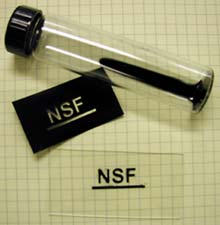New Molecule Heralds Breakthrough in Electronic Plastics

An organic solution of Oligotron mixed with chemicals that help the material set under ultraviolet light (top, in vial); a "mask," made by a laser printer on an overhead transparency, which was used to control the exposure of light (middle); and a photoprinted “NSF” image after exposure to ultraviolet light and rinsing (bottom). <br><br>Credit: Photo by Brian J. Elliott, TDA Research, Inc. <br><br>
New material could mean easier manufacture of paper-thin TVs and “smart” cloth
Researchers have developed a new plastic that conducts electricity, may be simpler to manufacture than industry counterparts and easily accommodates chemical attachments to create new materials.
Developed by TDA Research in Wheat Ridge, Colo., Oligotron polymers are made of tiny bits of material that possess a conducting center and two, non-conducting end pieces. The end pieces allow the plastic bits to dissolve in solvents and accommodate specialized molecules.
For decades, researchers have been trying to craft electronics that use plastics instead of metal to transmit currents. In addition to the potential savings in weight and cost, conducting polymers could be manufactured in a variety of convenient shapes, yielding such innovations as fabrics that transmit data and incredibly thin video displays.
However, because conducting polymers initially were not soluble in liquids, they could not be manufactured as easily as could their common counterparts used in soda bottles and synthetic fibers. Recent discoveries resulted in a water-soluble conducting polymer called PEDOT (polyethylenedioxythiophene), yet water can corrode device parts during manufacturing and shorten the lifespan of the end product.
Oligotron, developed with National Science Foundation (NSF) Small Business Innovation Research (SBIR) support, contains a PEDOT center, but it is soluble in non-corrosive chemicals and can attach new compounds to its end pieces, adding a variety of functions. For example, researchers have proposed end pieces that convert solar energy into electricity, ultimately creating a novel solar cell material.
Oligotron also has special properties that allow the material to be “printed” into various device shapes. When technicians shine a pattern of ultraviolet light, such as a complex circuit image, onto a film of dissolved Oligotron, the exposed areas of plastic become “fixed” like a photograph. Flexible and lightweight, the circuit is also fully functional.
TDA researchers predict applications for the product that range from flexible television displays and smart cards to antistatic treatments and conducting fabrics.
Oligotron is a trademark of TDA Research, Inc.
Comments from the researchers:
“Through our research we discovered that by attaching molecules to the ends of the PEDOT, the chemical could easily disperse in organic solvents, something we have not seen with typical conducting polymers.”– Brian Elliott, Senior Chemical Engineer, TDA Research, Inc.
“When we added photo-sensitive end groups to the Oligotron we created a material that could be printed using an ultraviolet light source. Using a patterned light source resulted in a patterned image that could conduct electricity.” – Brian Elliott, Senior Chemical Engineer, TDA Research, Inc.
“We began this research with the goal of developing easier methods to manufacture electronic devices with conducting polymers. We wanted to solve the problems related to the difficulties of dispersing conducting polymers in non-corrosive, organic solvents and create an easy method to print detailed features.” – Brian Elliott, Senior Chemical Engineer, TDA Research, Inc.
“We were surprised to discover that the Oligotron could conduct electricity almost as well as the completely non-dispersible, pure form of the PEDOT polymer.” – Brian Elliott, Senior Chemical Engineer, TDA Research, Inc.
“The reactive chemical groups on the ends of the Oligotron molecules will allow other scientists to synthesize new molecules, building additional functionality onto the molecule. These molecules will allow chemists to use their creativity to invent new materials with conducting polymers.” – Brian Elliott, Senior Chemical Engineer, TDA Research, Inc.
NSF comments regarding the discovery:
“Flat-panel displays are probably the largest market for organic electronic materials. The development of soluble polymers could have a large impact on the cost and ease of processing these displays.” – Winslow Sargeant, the NSF program officer who oversees TDA’s award.
“This is a significant breakthrough: a soluble and highly conductive multi-block copolymer, with its ability to be photo-crosslinked, could lead to a printable conducting polymer with a high conductivity.”
Media Contact
More Information:
http://www.nsf.gov/od/lpa/newsroom/pr.cfm?ni=73All latest news from the category: Materials Sciences
Materials management deals with the research, development, manufacturing and processing of raw and industrial materials. Key aspects here are biological and medical issues, which play an increasingly important role in this field.
innovations-report offers in-depth articles related to the development and application of materials and the structure and properties of new materials.
Newest articles

Properties of new materials for microchips
… can now be measured well. Reseachers of Delft University of Technology demonstrated measuring performance properties of ultrathin silicon membranes. Making ever smaller and more powerful chips requires new ultrathin…

Floating solar’s potential
… to support sustainable development by addressing climate, water, and energy goals holistically. A new study published this week in Nature Energy raises the potential for floating solar photovoltaics (FPV)…

Skyrmions move at record speeds
… a step towards the computing of the future. An international research team led by scientists from the CNRS1 has discovered that the magnetic nanobubbles2 known as skyrmions can be…





















